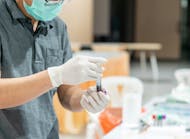Digenes chairman/CEO Evan Jones discusses disease-specific molecular diagnostic tests, womens health issues and consumer health advocacy
July 1, 2003
Evan Jones: New diagnostics technologies and advances in our understanding of disease have the potential to significantly improve the quality of diagnostic medicine and clinical outcomes. We are already seeing the benefits of these new technologies in areas of diagnostic medicine, such as virology, cardiac medicine and cancer diagnostics. Over the next five years, we should see an acceleration of this trend, particularly in molecular diagnostic testing, where many new tests are becoming available, and the automation and reliability of testing is improving.Bersch: How important a role will molecular diagnostic tests play in improving the quality of diagnostic medicine?Jones: We have a unique opportunity with the advent of disease-specific molecular diagnostic tests to help significantly improve clinical outcomes, while simultaneously reducing overall healthcare costs. The opportunities for improved standards of care and personalized medicine are perhaps most apparent in womens health diagnostic testing. In this area, we are seeing improved patient management for breast cancer patients with Her2Neu testing, more effective screening for chlamydia and improved management of women with borderline Pap smear results through HPV testing.Bersch: Will your new DNAwithPap test change how cervical cancer screening is performed?Jones: The new DNAwithPap test will build on these trends by improving the reliability and overall accuracy of cervical cancer screening. In March 2003, the FDA approved the DNAwithPap test for adjunctive screening. This important decision, offering women and their physicians the first objective measure of risk of cervical cancer, represents a major advancement in the fight against cancer. In their announcement of the approval, the FDA indicated that women who have normal Pap test results and no HPV infection are at very low risk (0.2%) for developing cervical cancer. Women who have an abnormal Pap test and a positive HPV test are at higher risk (6% to 7% or greater) of developing cervical cancer if not treated.Bersch: What type of studies did Digene perform to help establish the clinical effectiveness of HPV testing?Jones: The hc2 High-Risk HPV test was validated in large-scale clinical trials first for management of women with ASCUS Pap smear results and, more recently, for use as a routine adjunctive screening test. For ASCUS testing, the National Cancer Institute conducted the ALTS clinical trial that demonstrated sensitivity of 96% for detection of high-grade cervical disease and cancer and a sensitivity of just 85% for liquid-based cytology. As a result of this large clinical trial and others, the ASCCP published clinical practice guidelines indicating that an HPV test was the preferred method of follow-up to a liquid-based ASCUS Pap smear result. The guidelines were endorsed by 17 medical societies and organizations. Several cross-sectional and prospective cohort studies were conducted, involving more than 40,000 women on five continents. These provide strong evidence for the use of HPV testing as a routine adjunctive screen. Based on these study results, the American Cancer Society published cervical cancer screening guidelines in November 2002, with preliminary recommendations on the use of HPV testing for routine screening in combination with Pap.Bersch: Education of physicians is an important aspect of introducing new technology into the market. How will you educate physicians about the use of molecular diagnostic testing for cervical cancer?Jones: Methods of educating physicians about the benefits of new diagnostic technology have evolved significantly over the last several years. For example, the Society of Gynecologic Oncologists, the ASCCP, the NCI and the ACS are taking the lead on physician education for the DNAwithPap test through the publication and dissemination of clinical practice guidelines on their websites, professional channels and CME activities. Digenes physician-education efforts include direct-to-physician education through a dedicated physician detailing team and joint education programs with clinical laboratories.Bersch: What is your strategy for web-based activity?Jones: Web-based education has become a high priority because of its effectiveness in reaching large numbers of people at reasonable cost. Digene supports branded educational websites such as Thehpvtest.com, Puttingwomenshealthfirst.org and the campaigns of nongovernmental organizations through unrestricted grants. The National Cervical Cancer Public Education Campaign has nearly 20 campaign participants approved messages about methods of cervical cancer screening are carried on the campaigns website.Bersch: Establishing reimbursement is a major challenge for new diagnostic technologies. What have been the keys to Digenes success in this area?Jones: Obtaining a critical mass of reimbursement is one of the largest obstacles to the introduction of new diagnostic tests. Success with reimbursement begins with product development and continues through to the point where comprehensive reimbursement has been obtained. Our approach is to focus product development resources on new diagnostic tests that will both improve clinical outcomes and reduce costs to the healthcare system. It is important to obtain FDA approval, proper coding, CMS reimbursement and to publish peer-reviewed studies in prestigious medical journals documenting the effectiveness of the new technology. Once these elements are in place, a team of reimbursement professionals needs to work individually with virtually every payor to provide appropriate information and ultimately, assuming success, uniform coverage.Bersch: How do you expect screening for cervical cancer to evolve in the clinical laboratory through the balance of this decade?Jones: We should see exciting changes in cervical cancer screening over the next three to five years. For the last 50 years, the approach to cervical cancer screening has been to perform a good but not perfect test the Pap smear annually, in order to assure the identification of disease. While this approach to screening has been effective in reducing mortality from cervical cancer, it has been at a high cost. There continue to be cases of missed disease. With the advent of the DNAwithPap test, it should be possible to build on our successes with the Pap smear while bringing overall levels of accuracy closer to the sensitivity and confidence levels seen in areas such as blood screening. Laboratories, physicians and women will be able to take comfort in the knowledge that underlying disease is successfully identified, and a womans risk of having or developing cervical disease has been assessed.Bersch: What is Digenes strategy for automating HPV diagnostic testing?Jones: Automation of cervical cancer screening and HPV testing is becoming increasingly important. We have developed and are currently validating an application for the hc2 High-Risk HPV test using a new reagent handling and processing system the Rapid Capture system. An application for the Rapid Capture system has received FDA clearance for chlamydia and gonorrhea testing, providing the ability for one technician to perform up to 350 tests in a single shift. We expect to submit a PMA supplement to the FDA for the use of the system for HPV testing in the early fall.Bersch: Why are diagnostic companies getting more involved in consumer education? What approaches do you see as being most effective?Jones: Consumers are taking a much bigger role in advocating for their health by requesting that physicians make state-of-the-art diagnostics and therapeutics available. Recognizing this trend, it is more important than ever to be proactive in the area of consumer education. Ideally, third-party organizations should take the lead in consumer education, in conjunction with parallel physician education efforts. For example, with the DNAwithPap test launch, the ACS and the Gynecologic Cancer Foundation have taken active roles in communicating how the new technology fits into the overall screening framework. Last month, GCF sponsored a gynecologic cancers supplement in the annual New York Times Womens Health section, which addressed the latest screening and diagnostic technologies for cervical cancer prevention. Online and other broadcast media have also become important elements in a well-balanced consumer education program.
Evan Jones is chairman of the board and CEO of Digene Corp., an emerging growth biotechnology company focused on womens health diagnostic testing. He served as president and CEO of Digene from 1990 to 1999. Prior to that, Jones served for three years as president of Neomorphics Inc., a Boston-area company specializing in transplantation technologies. Between 1987 and 1990, he was first an associate, then a partner, with the CW Group, a healthcare venture capital firm.From 1983 to 1987, Jones was employed by Perkin-Elmer Corp., a biotechnology supply company, ultimately serving as its worldwide biotechnology marketing manager. He received a bachelors degree in Biochemistry from the University of Colorado and an MBA from The Wharton School, University of Pennsylvania. He is a member of the board of directors of the Childrens Research Institute at the Childrens National Medical Center and the board of visitors at the University of Maryland College of Life Sciences.
July 2003: Vol. 35, No. 7© 2003 Nelson Publishing, Inc. All rights reserved.
July 2003: Vol. 35, No. 7© 2003 Nelson Publishing, Inc. All rights reserved.






